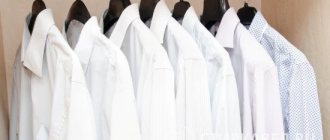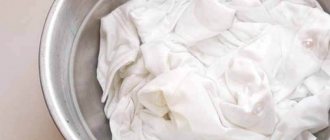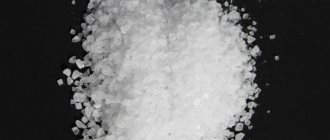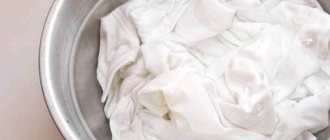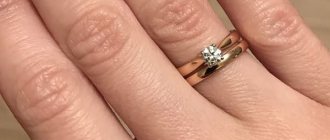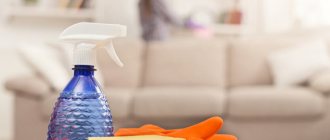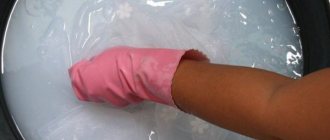If you discover dirt on clothes late, it will be quite difficult to wash it. Numerous washes and powders often do not solve the problem. However, this does not mean that you should throw things away immediately. It is quite possible to get rid of stains at home without special treatment or dry cleaning.
How to bleach white clothes with peroxide?
There are some products whose range of applications is quite wide, especially if the housewife is smart enough to use this or that product not only for its intended purpose. In this case, hydrogen peroxide is no exception.
It turns out that hydrogen peroxide can be used not only to treat wounds, scratches and other mechanical damage on the body, disinfecting them, but also to use the product to whiten things.
The main advantages of using the product in question in washing are:
- savings - peroxide is quite inexpensive, unlike cleaning agents and detergents used for similar purposes
- Availability - can be found at any pharmacy
- ease of use - you do not need to have special skills and knowledge to use the product in the laundry
- effectiveness - is a fast-acting whitening agent
- practicality - will help you get rid of stains of varying complexity quickly and easily
Hydrogen peroxide is used to whiten stains:
- clothes (from a wide variety of materials)
- furniture (upholstery, bedspreads, etc.)
It should be noted right away that the main thing in washing is to choose the right product for getting rid of stains or bleaching, as well as the temperature regime, because if you choose the wrong detergent or wash the item in water at the wrong temperature, you can subject your clothes to serious tests which may end:
- loss of color
- "shedding" clothes
- thinning or even tearing of tissues
Experienced housewives know a number of “golden” rules that must be followed in any case when washing things in order to get clean clothes without loss of color:
- It is better to soak heavily dirty laundry for a while before washing it directly;
- use special products suitable for these purposes for washing certain items (examine the label on clothing or linen, etc.);
- do not wash multi-colored and white items in the same water (do not mix them during this process, and it does not matter whether you wash by hand or not);
- It is undesirable to boil things, this affects their durability and strength;
- it is possible to use traditional methods in washing (including the use of hydrogen peroxide);
- You need to dry any clothes under ultraviolet rays (white clothes can take longer, colored clothes should be removed a little more damp so that the sun does not have time to burn out their color);
- Do not bleach things frequently;
- You should not bleach items made from different fabrics and materials together.
Everything is quite simple, but these are the rules that become the key to success in washing.
Whitening with hydrogen peroxide also has its own rules, which you must know before using this product in the laundry:
- If you decide to bleach cotton items or items made from synthetics or linen, then you can carry out the bleaching process in a washing machine. To do this, you need to add only 10 ml of peroxide to 100-120 ml of the selected detergent and wash the products for about 5-6 minutes. The temperature in this case can be 60-800.
- Bleaching of woolen items with this product is carried out as follows:
- prepare a solution - 10 liters of water (can be hot) + powder + 200 ml of peroxide
- immerse wool items in the solution for 4-5 minutes
- rinse things in cold water (thoroughly)
- Since underwear is most often made from fairly delicate fabrics, it is best not to bleach them by washing them in a washing machine. It is better to perform this process manually:
- fill a bowl full of warm water (not hot)
- make a solution: add a few tablespoons of hydrogen peroxide to water
- stir well
- leave the underwear in the prepared substance for an hour and a half
- then wash as usual
As you can see from the information above, bleaching with peroxide is not difficult, the main thing in this process is to take into account the material from which the things are made.
Disadvantages of Traditional Whitening Products
There are a huge number of whitening products on the market. However, most of the modern remedies have a number of significant drawbacks, so “grandmother’s” soda remedy still remains effective and in demand.
Disadvantages of modern bleaches:
- Aggressive chemicals that cause allergies. Also, such “chemistry” can seriously damage the fabric.
- Fading of some materials. If you didn’t get the dosage right, you can say goodbye to the bright color of your favorite thing.
- Price. Widely advertised bleaches “delight” with a completely undemocratic price, while a solution made from soda will cost you pennies.
- Diversity. Each type of bleach is designed for a specific type of fabric, so to clean things made from different materials (synthetics, cotton, silk, etc.) you will have to pay a significant amount.
How to bleach white things with soda?
It is quite difficult to exaggerate the usefulness of soda, because this substance is a universal remedy. It is used in:
- for medicinal purposes (for heartburn, for teeth whitening)
- cleaning (washes away various types of dirt)
- washing (bleaching various fabrics)
If your white clothes need bleaching, you can use soda for this, but bleaching will be most effective if you add ammonia to the soda. So here's a simple way to make things whiter:
- in 6 liters of non-hot water you need to dissolve 6 tablespoons of baking soda and 3 tablespoons of ammonia
- mix everything well
- soak white items in the solution for several hours
- after which it is necessary to rinse them as required
- wash as usual (depending on the material of the items)
You can also bleach a white tablecloth during automatic washing. To do this, you just need to pour a few tablespoons of soda into the drum of the machine before starting it.
If the stain is fresh, you can pour a little baking soda on it and moisten it with water, leave it in this state for half an hour, and then start washing the item.
Delicate fabrics need to be bleached wisely, so in some cases it is better not to use soda for bleaching. Don't forget, baking soda can corrode your hands if you have prolonged contact with it, so gloves won't hurt in this process.
Precautions during use
- Most fabrics are damaged by aggressive bleaching agents. Therefore, you should not soak things in them for a long time, and also do not exceed the permissible amount of drugs.
- If there are rust stains on things, then when using chemical bleaches, the rust can move to all the laundry, which will further ruin its appearance.
- Items with metal fittings should not be soaked in high temperature water. 40 degrees is enough.
- Bleaching of laundry must be done in plastic basins. Chips on enamel cookware may react undesirably with bleaching agents.
- Bleach and other chlorine-containing bleaches should be used only as a last resort, so as not to expose the fabric to the negative effects of this substance.
- Before bleaching your laundry at home, read the labels on the items. If they have an icon in the form of a triangle crossed out by two lines, then this procedure cannot be carried out.
We suggest you familiarize yourself with Which bed linen is the best in quality
It is important to remember that soda is an aggressive product. When using it when washing, you must consider the following points:
- To prevent the skin of your hands from drying out, you need to use rubber gloves. Sodium carbonate, getting into small wounds and cracks, destroys the upper layers of the epithelium, the lesions increase.
- Do not use baking soda when working with delicate fabrics - silk, wool.
- Do not allow the composition to come into contact with mucous tissues or eyes. If this happens, immediately rinse the affected area with running water.
- Avoid getting moisture into the pack of soda - its contents will form clumps and the effectiveness of the baking powder will decrease.
You need to be especially careful when working with dark fabrics - at high temperatures, the effect of soda is enhanced many times over. Colors may fade.
How to bleach white things with white?
Inexperienced young housewives do not often buy white things or bed linen, because they believe that after just a few washes, the linen will become dull, and it will no longer be possible to return it to its shining whiteness. Let’s say right away that this opinion is wrong and now we will prove it.
A fairly old method of bleaching clothes is the use of bleach. Our grandmothers also used this method. Let's find out the details of this method:
- do not forget that the whiteness is made on the basis of chlorine, which means that this product is effective and quite caustic
- It is better to work with white with gloves
- The product is intended for bleaching dense materials
- Do not use white for silk, colored fabrics, wool
Application of whiteness in hand washing:
- draw water (temperature depends on the type of fabric)
- add the required amount of white (there are detailed instructions on the package)
- stir the solution
- soak things in it (25 minutes will be enough)
- rinse things in cold water (at least 3-4 times)
It is better not to use hot water for bleaching whites.
Whitening in the washing machine:
- dilute white 1:3 with water
- pour the solution into the drum of the machine
- Before bleaching in the machine, it is advisable to moisten things a little
- run the selected program (do not use high temperature modes)
It is necessary to use white in machine washing only in extreme cases, because this product can damage both the fabric and the washing machine itself.
What we don't recommend
We have studied many methods for bleaching towels, not only theoretically, but also practically. The methods described above were tested successfully, but we dare not recommend soaking in a solution of potassium permanganate and mustard for white towels.
After such treatment, snow-white fabrics acquired a dirty tint (after potassium permanganate - grayish, after mustard - yellowish), as a result they had to be additionally boiled in bleach with chlorine. And this is not a very desirable option for a thrifty housewife.
Follow the right tips and your kitchen will be sparkling clean.
How do you like the article?
How to bleach white things with aspirin?
When you find out that it turns out that aspirin can whiten things, you feel a bit uneasy, because people usually take it for a headache or fever. Despite such an impressive statement, the effect of this whitening method is excellent.
So, let’s take a closer look at the bleaching method by using tablets, known to us all, aspirin in the laundry:
- For 8-10 liters of water you will need a handful of aspirin (namely 5 tablets);
- We select from the dirty items those that you want to bleach (remember that these should not be colored items or too thin fabrics);
- Completely immerse things in the prepared aspirin solution;
- Leave them soaked for 6-7 hours;
- For maximum efficiency and cleanliness, you need to wash items after soaking on the usual cycle in the washing machine or by hand.
It is also worth noting that aspirin tablets do an excellent job of removing blood stains, so keep this fact in mind (especially since it has been repeatedly tested in practice).
How to bleach white things with ammonia?
Ammonia is an excellent ingredient for a bleach solution. Usually it is not used as an independent remedy, because it can be most effective in combination with soda.
In order for grayed and not entirely new things to acquire their former whiteness, it is necessary:
- pour 5-7 liters of water into a basin
- add a few tablespoons of regular baking soda
- mix everything well
- pour just a little ammonia
- dip things into the previously prepared solution
- leave them in the solution for several hours
- then wash them as usual
- rinse very well
- dry under ultraviolet rays
This is a truly effective method that has been tested by time, the main thing is that the things that you decide to bleach are not made of too thin fabric, because the components of the solution can affect their strength and even contribute to their “corrosion.”
What is the difference between soda ash, baking soda and caustic soda?
Baking soda, soda ash and caustic soda belong to the group of sodium compounds of alkaline origin. Moreover, all three substances have different chemical formulas.
Baking soda has a low pH value and is used in minimal quantities when cooking. Calcined is more aggressive, it is necessary exclusively for technical and household purposes.
Caustic soda is a caustic alkali that requires strict adherence to safety rules. It is involved in many industries.
How to bleach white clothes with vinegar?
Another good way to keep your whites clean is to add distilled sting (white) to your laundry:
- maintains whiteness (restores it if necessary)
- softens the fabric
- Helps prevent white items from pilling
- reduces the possibility of an allergic reaction to other components involved in the washing process (detergents)
Bleaching and washing things with distilled vinegar:
- It is enough to add half a glass of the vinegar in question to the laundry and put it in a regular wash in the washing machine so that the color of the items is preserved for a long time;
- just 1/4 cup of vinegar can remove stains from a variety of foods from a white item;
- add a little baking soda (helps to roll off various types of stains) and distilled vinegar (just half a glass) to a bowl of warm water where you are going to bleach things, and your things will become snow-white, clean and soft.
- If you need to return the whiteness to clothes or other things, soak them overnight in warm water with a glass of vinegar added, and wash them in the morning (can be done by hand or in a washing machine)
A great way to whiten clothes is to add one and a half cups of the product in question to the rinse cycle, or soak your clothes in a vinegar solution for several hours, then wash them.
Unique properties of soda in bleaching underwear
Soda is recognized as a universal remedy that can be found in the kitchen of any housewife. In addition to its nutritional value and the many ways it can be used in preparing various dishes, baking soda is excellent at bleaching different types of fabrics. When mixed in certain proportions with other products, it is an indispensable assistant in the fight against even the most difficult stains, as well as the smell of cigarettes and tobacco on clothes. The advantageous properties of soda when faced with the task of whitening underwear include:
- Availability - this product is relatively inexpensive, it is sold in any grocery store;
- Safety of use - soda does not contain any harmful substances; even children's clothes that require special washing and heat treatment can be bleached with soda;
- Ensuring protection of the washing machine from scale formation - with periodic addition of soda, salt deposits do not form on the heating elements of the device;
- Removes odors, incl. the smell of sweat from clothes.
- Preservation of the original structure of fabrics - in comparison with conventional bleaching agents of chemical origin, soda does not destroy the internal fibers, thereby preserving the original appearance of the material.
The product can be used separately for whitening or added to powders or used simultaneously with other natural substances. For example, bleaching a bra with soda and salt is not difficult if the proportions and manipulation technique are followed.
Salt is also indispensable when you need to remove greasy stains from clothes.
We bleach things from various stains
White clothes, bedding and underwear require additional care, which is why every housewife must know how to bleach this or that item.
How to bleach faded white clothes?
“How to bleach white clothes that have been dyed during washing?” – this is the question many inexperienced or inattentive housewives ask. You can purchase special laundry detergents for these purposes, but remember, the sooner you start bleaching faded items, the greater the likelihood of your success in this matter.
Folk remedies are proven methods in this difficult matter:
- Immediately after you discover that white items have faded, wash them thoroughly with laundry soap.
- If the fabrics of faded items are thick enough, you can use white.
- If you have oxygen bleach in your closet (this is the easiest way to bleach faded clothes), then your whites will return to their original color within a few minutes of washing with it.
How to bleach yellowed white clothes?
White things, unfortunately, turn yellow over time, and some housewives believe that the time for such things has expired and it’s time to dispose of them. In fact, there are several effective ways to restore the snow-whiteness of your things:
- An integrated approach - mix salt and regular washing powder:
- You will need several glasses of laundry detergent with a few spoons of persol
- add this mixture to water
- put on fire
- throw the laundry in there
- boil things thoroughly
- Washing powder with potassium permanganate is an excellent option for whitening things:
- you will need 5 liters of water
- you need to add a little potassium permanganate to it (such an amount that the water is slightly pink) and powder - 100 g
- beat the foam on the resulting solution
- place yellowed laundry there
- boil
- do not remove things from there until the water becomes completely cold
How to bleach sweat from white clothes?
This problem affects anyone and everyone who likes to wear white things. So, let's talk about how to whiten armpits on white things :
- If the item is made of thick fabric, sprinkle kitchen salt on the yellow stains and pour in alcohol. Leave it in this state for a while, then wash the item.
- If the sweat stains are fresh, then laundry soap will help whiten them. Lather the yellow areas well and leave for half an hour, then rub these areas well and wash the item as usual.
- Mix 200 ml of ammonia, 200 ml of denatured alcohol, add 800 ml of water and wash things with yellow stains in this solution.
If you wash white items more often, then yellow stains will not have time to eat into the fabric.
How to bleach white woolen items?
Items made from such fabrics are considered quite delicate, so the approach to bleaching them should be similar:
- Hydrogen peroxide - add a little of this when machine washing.
- Bleach (special for woolen fabrics).
- Soda - soak clothes in a soda solution, then wash.
- A safe way is chalk, but you will need a large amount of it. To wash one large woolen item you need at least half a kilogram. Add the required amount to water, soak the item for half an hour, then wash it thoroughly. Everything is quite simple and fast.
If you are wondering how to bleach white synthetic items, check out all the methods above, they will work great for this type of fabric.
Whichever of the presented methods you choose, the main thing is that you take into account the complexity of the stains and the density of the fabric itself from which the things are made. Bleaching cannot be called a completely simple process, but in order for things to regain their former whiteness, you will have to try.
Cleaning tiles and plumbing
We can help you easily clean a bathtub, toilet or sink: soda ash, baking soda, vinegar and bleach. The whole procedure takes half an hour, the work itself takes a few minutes, the rest of the time is needed for the soda to have time to eat away the dirt. This product effectively dissolves soap deposits, sebum, limescale, urinary stone (in the toilet) and removes traces of rust around the drain and taps.
We will need:
- Soda ash and baking soda 3 tbsp. l.
- A third of a glass of liquid bleach and the same amount of table vinegar.
- Sponge and spray bottle.
Mix baking soda and soda ash, rinse the bathtub, toilet or sink with water, dip a damp sponge into the resulting powder and apply to the surface, you can rub it lightly. Leave the product to allow the baking soda to penetrate the dirt and begin to break it down.
After half an hour, apply a mixture of bleach and vinegar on top of the soda; it is convenient to use a spray bottle for this. Don't be alarmed if the product starts to hiss and foam - this is normal, as it should be. When the reaction is complete, rinse the plumbing with water from the shower head; if there are small specks of dirt left, rub them with the hard side of the dish sponge and they will be easily washed off.
To wash the tiles, use a soda solution (2-3 tablespoons per liter of water), and rinse off the remaining product with clean water.
